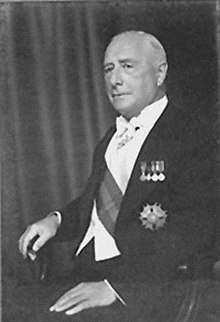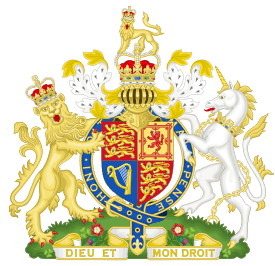Patrick Duncan (South African politician)
Sir Patrick Duncan, GCMG, KC (21 December 1870 – 17 July 1943) was the sixth Governor-General of the Union of South Africa, holding office from 1937 to 1943.
Sir Patrick Duncan GCMG, KC | |
|---|---|
 | |
| 6th Governor-General of South Africa | |
| In office 5 April 1937 – 17 July 1943 | |
| Monarch | George VI |
| Prime Minister | James Barry Munnik Hertzog Jan Christiaan Smuts |
| Preceded by | The Earl of Clarendon |
| Succeeded by | Nicolaas Jacobus de Wet as Officer Administering the Government |
| Minister for the Interior, Educationand Public Health | |
| In office February 1921 – 30 June 1924 | |
| Prime Minister | Jan Smuts |
| Preceded by | Thomas Watt F. S. Malan (Education) |
| Succeeded by | Daniel François Malan |
| Personal details | |
| Born | 21 December 1870 Fortrie, Banffshire, Scotland, United Kingdom |
| Died | 17 July 1943 (aged 72) Pretoria, Transvaal, South Africa |
| Nationality | Anglo-South African (also British subject) |
| Spouse(s) | Alice Dold |
| Alma mater | University of Edinburgh Balliol College, Oxford |
Early life
Born in Scotland in 1870, he took degrees in classics at the University of Edinburgh and at Balliol College, Oxford, and studied law in the Inner Temple, before joining the British civil service in 1894 as a Clerk of the Upper Division in the Secretaries' Office for Inland Revenue.[1]
Colonial service
In 1901, during the Anglo-Boer War (1899–1902), he was recruited by Viscount Milner, to join a team of young administrators - known as "Milner's Kindergarten" - to govern and anglicise the British-occupied Transvaal. He was Colonial Secretary of the Transvaal from 1903 until the colony was granted self-government in 1907, playing an important part in the repatriation of ex-prisoners of war, and in the social and financial reconstruction of the former Boer state.
Duncan practised as an attorney from 1907 to 1910, and was a legal adviser to the Transvaal delegation to the 1908-1909 National Convention that drew up the South Africa Act that established the Union of South Africa.
Political career
He was a member of the Union Parliament from 1910 to 1936, first as a member of the Unionist Party, then of the South African Party and its successor the United Party. He was Minister of Education, the Interior, and Public Health in the SAP administration from 1921 to 1924, and Minister of Mines in the UP administration from 1933 to 1936.
Governor-General of South Africa
Duncan was appointed Governor-General in 1937, the first South African citizen appointee to hold the post. King George VI, whom he represented as head of state, knighted him and appointed him to the Imperial Privy Council.[2]
Although widely respected and above party politics, he made himself controversial in 1939 by refusing to call a general election on the question of whether or not the Union should enter World War II. The prime minister, General Hertzog, wanted to stay neutral, but Parliament supported his deputy, General Smuts, who proposed to declare war. Hertzog resigned, Smuts became prime minister and led the country into war, and political re-alignments followed.
Sir Patrick died in office, in 1943. His ashes were interred in a monument at the new Duncan Dock in Cape Town harbour, which was named after him. The informal township of Duncan Village in East London, and the suburb of Duncanville near Vereeniging, were also named after him.
Family
Sir Patrick married Alice Dold in 1916. They had three sons and a daughter. One son, Andrew (1920–1942), was killed on active service in Libya. Another son, Patrick (1918–1967), was a well-known anti-apartheid activist.
Titles, styles and honours
| Viceregal styles of Sir Patrick Duncan | |
|---|---|
 | |
| Reference style | His Excellency |
| Spoken style | Your Excellency |
| Knight Grand Cross of the Order of St Michael and St George (GCMG) | 1937[3] | |
| Companion of the Order of St Michael and St George (CMG) | KB 1904[4] | |
| Knight of the Venerable Order of St John of Jerusalem (KStJ) | KB 1937[5] | |
| King George V Coronation Medal | 1911 | |
| King George V Silver Jubilee Medal | 1935 | |
| King George VI Coronation Medal | 1937 |
References
- "No. 26518". The London Gazette. 1 June 1894. p. 3196.
- "No. 34396". The London Gazette (Supplement). 11 May 1937. p. 3075.
- "No. 34369". The London Gazette. 9 February 1937. p. 888.
- "No. 27688". The London Gazette (Supplement). 21 June 1904. p. 4009.
- "No. 34410". The London Gazette. 22 June 1937. p. 4007.
- Dictionary of South African Biography Volume I
- Standard Encyclopedia of Southern Africa Volume 4
- Lavin, Deborah, ed. (2010). Friendship and union. The South African letters of Patrick Duncan and Maud Selborne, 1907-1943. Cape Town: Van Riebeeck Society. ASIN 0981426417.CS1 maint: ref=harv (link) CS1 maint: ASIN uses ISBN (link)
External links
- "Archival material relating to Patrick Duncan". UK National Archives.

- Newspaper clippings about Patrick Duncan in the 20th Century Press Archives of the ZBW
| Government offices | ||
|---|---|---|
| Preceded by Walter Edward Davidson |
Colonial Secretary of the Transvaal 1903–1907 |
Succeeded by Jan Smuts |
| House of Assembly of South Africa | ||
| New constituency | Member of Parliament for Fordsburg 1910–1920 |
Succeeded by Morris Kentridge |
| Preceded by Dr William Davies |
Member of Parliament for Yeoville 1921–1936 |
Succeeded by Henry Gluckman |
| Political offices | ||
| Preceded by Thomas Watt |
Minister for the Interior 1921–1924 |
Succeeded by Daniel François Malan |
| Preceded by François Stephanus Malan |
Minister of Education 1921–1924 | |
| Preceded by Thomas Watt |
Minister for Public Health 1921–1924 | |
| Preceded by Adriaan Paulus Johannes Fourie as Minister of Mines and Industry |
Minister of Mines 1933–1936 |
Succeeded by Jan Hendrik Hofmeyr |
| Government offices | ||
| Preceded by The Earl of Clarendon |
Governor-General of South Africa 1937–1943 |
Succeeded by Nicolaas Jacobus de Wet |
.svg.png)
.svg.png)